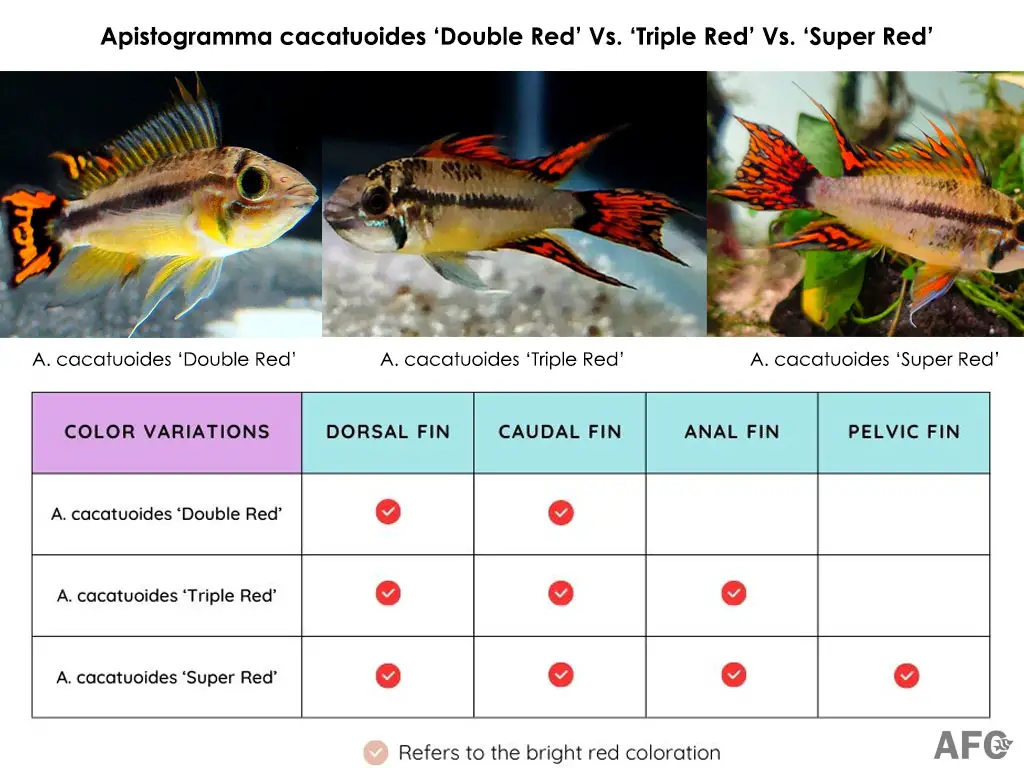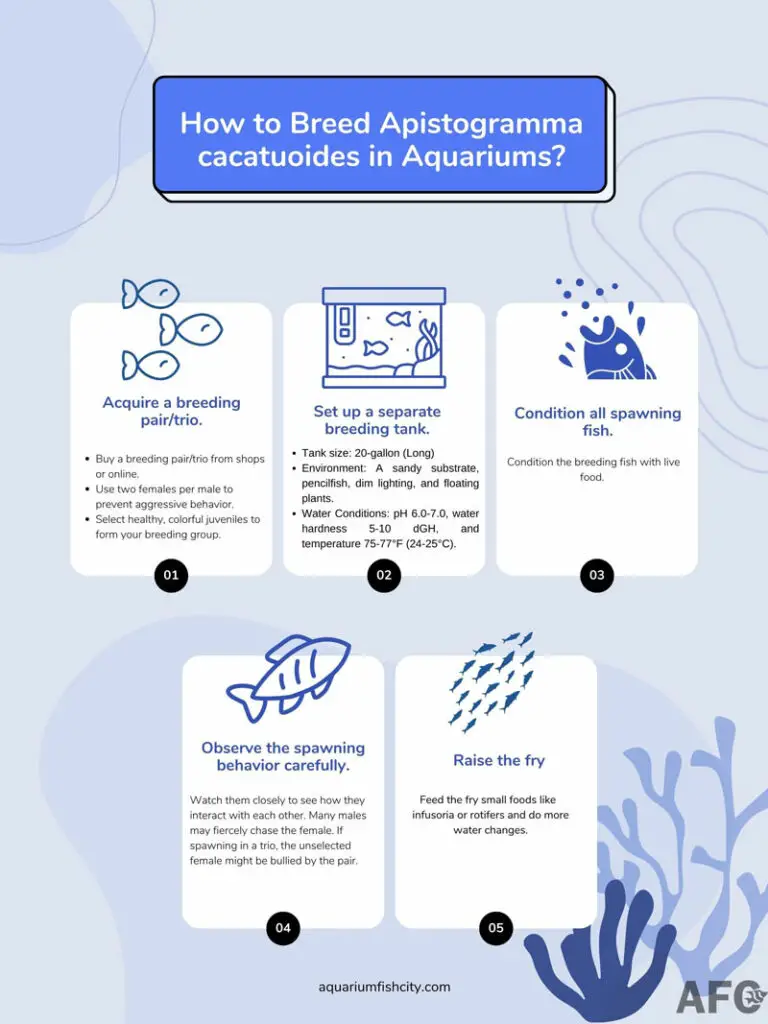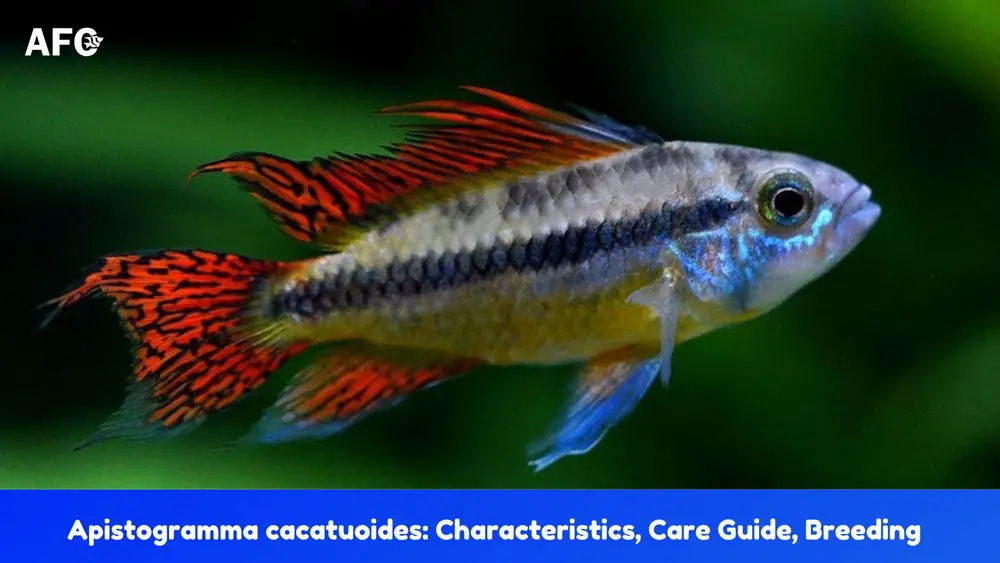Apistogramma cacatuoides, commonly known as the cockatoo dwarf cichlid, is arguably the most popular of the Apistogramma species in the hobby. The common name is derived from its large, crested dorsal fin.
The cockatoo cichlid is so popular because of its vibrant colors. It comes in many stunning color variations, such as Double Red, Super Red, Triple Red, and Orange Flash. No matter what color morph it is, gender differences are apparent when the fish reach adulthood.
These small-sized apistos are mostly captive-bred or tank-raised and are easy to care for. However, male A. cacatuoides have a reputation for being aggressive due to their polygynous mating system.
A. cacatuoides is also easy to breed because it is one Apistogramma species that originally comes from both whitewater and clearwater habitats, but not blackwater habitats. Therefore, it does not really need acidic and very soft water to reproduce, which is another reason for its popularity.
Read on to learn all you need to know about the cockatoo dwarf cichlid and how to take care of and breed them.
What is Apistogramma cacatuoide?
Apistogramma cacatuoides is a binominal name used to universally identify and name the cockatoo dwarf cichlid. The specific epithet “cacatuoides” is a combination of the Malay word “cacatu” meaning “cockatoo,” and the Greek word “oides,” meaning “like.” Thus, Apistogramma cacatuoides means “like a cockatoo,” which refers to the spectacular dorsal fin.
Because of their wide geographical range in the western Amazon drainage basin, A. cacatuoides is considered to be a superspecies. This means that it consists of several closely related species that evolved from a common ancestor but occur geographically separately.
After first being introduced to the aquarium trade in 1950 under the name Apistogramma U2, these fish then spent several decades being misidentified under another name, Apistogramma borellii, until the mistake was finally corrected sometime in the 1980s.
Today, A. cacatuoides is the most recognized member of this family and comes in many color varieties in the pet fish market.
What Are the Types of Apistogramma cacatuoides?
These are the most readily available types of Apistogramma cacatuoides.
- Apistogramma cacatuoides ‘Double Red’
- Apistogramma cacatuoides ‘Triple Red’
- Apistogramma cacatuoides ‘Super Red’
- Apistogramma cacatuoides ‘Orange Flash’
Apistogramma cacatuoides ‘Double Red’
A. cacatuoides ‘Double Red’ is a color variety of the Apistogramma cacatuoides species. This morph refers to the bright red coloration found on both the dorsal and caudal fins of males.
Apistogramma cacatuoides ‘Triple Red’
A. cacatuoides ‘Triple Red’ is a color morph of the Apisto cacatuoides characterized by vibrant red coloration on the dorsal, caudal, and anal fins of males. Its red anal fin coloration sets it apart from the ‘Double Red’ morph.
Apistogramma cacatuoides ‘Super Red’/ “Quad Red”
A. cacatuoides ‘Super Red’ or ‘Quad Red’ is a man-made variation of the cockatoo dwarf cichlid, recognized for its intense red coloration on the caudal, dorsal, anal, and pelvic (or ventral) fins of males. The redness on the pelvic fins is more predominant than a red outline on the edge.

Apistogramma cacatuoides “Orange Flash”
A. cacatuoides ‘Orange Flash’ is a recently developed morph of the cockatoo cichlid, displaying a brilliant solid orange coloration on the dorsal, anal, and caudal fins. The pectoral and pelvic fins feature hints of turquoise, making for a stunning overall appearance.
How to Tell a Male From a Female Apistogramma cacatuoides?
These are some of the most reliable ways to tell a male from a female Apistogramma cacatuoides.
- Color: Males are identified by the brilliant red coloration on their fins. Females are characterized by their yellowish tones, which turn intense bright yellow during spawning periods.
- Dorsal fin: Males have a tall, pointed dorsal fin, and the first three spines are significantly longer, whereas the females’ dorsal fins tend to be of equal size with shorter spines.
- Caudal (tail) fin: In males, the upper and lower lobes of the caudal fin dramatically elongate into a lyrate shape, while females have truncated tail fins.
- Pelvic (ventral) fin: The entire pelvic fin will become deep black in females when they are ready to spawn, while males will display a dazzling array of colors.
- Size: Males are generally larger than females.
It is challenging to differentiate males from females in juveniles because sexual characteristics have not developed. Juvenile females often have a yellow belly, while males possess a white belly. Additionally, their behavior can sometimes serve as a reliable indicator of sex, as juvenile males tend to display greater dominance than their female counterparts.

How Big do Apistogramma cacatuoides Get?
In captivity, males can grow up to 3.1 inches (8 cm) in standard length, while females are smaller, with an average size of 2 inches (5 cm).
In the wild, they reach a maximum size of about 2 inches (5 cm), according to the Check List of the Freshwater Fishes of South and Central America hardcover by Sven O. Kullander and Roberto E. Reis.
Are Apistogramma cacatuoides Aggressive?
No, A. cacatuoides are “semi-aggressive” fish. They are generally peaceful fish, but the dominant males are highly polygamous and mate with several females during the breeding season. They tend to be extremely aggressive toward females that are not ready to spawn in their territory.
No matter your aquarium setup, they do best in a harem situation with one male and 3-5 females to reduce the persistent reproductive behaviors of the male.
What Is The Minimum Tank Size For Apistogramma cacatuoides?
The minimum tank size for a trio or small group of adult A. cacatuoides is 20 gallons (Long). A larger tank is always better.
Like most dwarf cichlids, cockatoo dwarf cichlids are bottom dwellers and stay near the bottom of the tank. Given their relatively large size and the aggressive nature of males, a wider tank that has a larger bottom surface area is preferable to a tall, narrow one.
Because the male cockatoo cichlids can be territorial, keep only one male in a tank. Sizes larger than 75 gallons provide sufficient space for multiple males. However, few owners keep them in these larger-sized tanks.
Can You Keep Apistogramma cacatuoides In a 10-gallon Tank?
Yes, you can keep a single male A. cacatuoides in a 10-gallon tank or three to four juveniles if you plan to upgrade to a larger tank when they grow bigger.
How Long Does Apistogramma cacatuoides Live?
The average lifespan of Apistogramma cacatuoides in captivity is over two years. This species has a considerably longer life expectancy than other Apistogramma species, according to a statistical study conducted by Dr. Uwe Römer in 1991.
What is the Native Habitat of Apistogramma cacatuoides?
The native habitats of A. cacatuoides are slow-moving, whitewater, and clearwater tributaries of the Ucayali, Amazon, and Solimôes Rivers from the Pachitea River in Peru to the Tabatinga River in Brazil and Colombia, according to Froese and Pauly (2021).
These are regions of shallow water bodies beneath dense rainforest canopies that allow very little sunlight to come down.
A. cacatuoides live in small groups, mainly in sandy areas with scattered rotting driftwood, branches, and a thick leaf layer.
Mimicking their natural habitat in an aquarium is important to care for and breed these cichlids.
How to Take Care of Apistogramma cacatuoides?
The proper Apistogramma cacatuoides care includes the following basic necessities.
- Choose suitable tankmates.
- Optimize water parameters.
- Provide plenty of caves.
- Add floating plants to subdue the lighting.
- Use a fine sand substrate.
- Feed them live food.
Many aquarists consider this species to be undemanding, but we can say that in terms of domestic, line-bred strains. However, caring for wild-caught specimens can be challenging due to their feisty and sassy personalities.
What Are the Good Tank Mates for Apistogramma cacatuoides?
The good tank mates for Apistogramma cacatuoides are listed below.
- Freshwater Angelfish
- Geophagus cichlid
- Pygmy cory
- Otocinclus catfish
- Neon tetras
- Marbled Hatchetfish
- Rasboras
- Dwarf pencilfish
Angelfish and cockatoo dwarf cichlids do very well in large community tanks since these two South American cichlids prefer different water levels and will not compete for the same territories.
Geophagus are the large cousins of Apistos, known as sand-sifters or eartheaters. They can coexist in properly managed and decorated tanks.
Pygmy corys and otos make good bottom-dwelling companions for cockatoo cichlids because they can help keep the aquarium clean and are non-aggressive. Remember, these compact fish should be kept in groups of at least six or more.
Small tetras, hatchetfish, pencilfish, and rasboras are popular top-dwelling dither fish. They mostly swim in the upper third of the tank and provide plenty of activity.
A large group of small pencilfish and hatchetfish make ideal tankmates for A. cacatuoides because they are surface dwellers and have small mouths, making them safe for the fry of Apisto to come out and feed.
Can You Keep Apistogramma cacatuoides with Ram Cichlids?
Yes, you can keep Bolivian ram cichlids or German blue ram cichlids with A. cacatuoides in large, well-structured tanks. However, ram cichlids thrive at high temperatures, ideally between 84-86°F (29-30°C), while Apistogramma cacatuoides prefer cooler water temperatures of 75-77°F (24-25°C).
A. cacatuoides can tolerate elevated temperatures, but this will accelerate their metabolism and potentially shorten their lifespan.
Can You Keep Apistogramma cacatuoides and Shrimp Together?
No, you can’t keep A. cacatuoides and shrimp in the same tank. These cichlids are omnivores, meaning they will eat any food that fits into their mouths, including small invertebrates like shrimps and snails.
What Are The Water Parameters for Apistogramma cacatuoides?
According to a 2021 document by the U.S. Fish and Wildlife Service, the proper water parameters for keeping cockatoo cichlid are as follows.
- Water temperature: 75-77°F (24-25°C)
- pH range: 6.0 – 8.0
- dH: 5-19 dGH
Do Apistogramma cacatuoides Need Caves?
Yes, A. cacatuoides need caves not only because the male is highly polygamous and will invariably chase the female who is ready to spawn but also because the females need small caves to deposit her eggs.
In fact, a gravid female can be more aggressive than a male, and she may kill the male while defending the eggs in the nest, especially when the male again tries to breed with her. Therefore, you need to give the male shelter to hide in.
Do Apistogramma cacatuoides Need Plants?
A. cacatuoides do appreciate floating plants at the water surface because of their low light requirements. Rooted aquarium plants can add many benefits to an aquarium but are not necessary for Apistos.
In their native habitat, they live in sandy riverbeds with no aquatic vegetation but lots of fallen leaves and wood pieces that provide shelter.
What is The Best Substrate for Apistogramma cacatuoides?
Soft, fine-grain sand is the best substrate for Apistogramma cacatuoides. These fish are sand sifters, and they continuously plow through the tank substrate foraging for food. Other types of substrates can be sharp and irritate the fish’s delicate gills.
What Do Apistogramma cacatuoides Eat?
A. cacatuoides primarily feed on benthic invertebrates and insect larvae in the wild. In captivity, their favored foods include baby brine shrimp, bloodworms, glassworms, daphnia, and mosquito larvae. Tubifex and blackworms should be avoided since they are notoriously dirty and will foul the water.
Flakes and commercial pellets can be used for tank-raised fish, but always supplement their diet with live foods to maintain their good health and vivid colors. Like any other Apistogramma, they are bottom feeders, so provide sinking food for them.
How Often Should You Feed Apistogramma cacatuoides?
You should feed A. cacatuoides 2-3 times a day, but no more than they can consume within three minutes or less.

How to Breed Apistogramma cacatuoides?
These are five major steps to breed Apistogramma cacatuoides in the aquarium.
Step 1: Acquire a breeding pair/trio.
A breeding pair or trio (one male and two females) of cockatoo dwarf cichlid can be purchased in local fish shops or online. Wild-caught specimens are also available in the market, but they come with a high price tag and are often sought out by experienced hobbyists.
Because a male may furiously chase a female who is not ready to breed, it is best to introduce two females for every male.
You can also select your own group from a tank of juveniles. Choose the fish that has the best coloration, size, and health.
Step 2: Set up a separate breeding tank.
Unlike most Apistogramma species that require specific water conditions for spawning, the biggest difficulty in breeding the cockatoo dwarf cichlid is providing them with the proper environment where each fish can feel secure and comfortable.
To create a suitable spawning environment and mitigate their territorial aggression, you should use a separate 20-gallon (Long) or larger fish tank with some clear boundaries created by plenty of caves and other decorations.
The tank itself should have a sandy substrate, a group of pencilfish, dim lighting, and some floating plants. Although most tank-raised A. cactuoides are relatively undemanding in terms of water parameters, it is recommended to keep the pH at 6.0-7.0 and water hardness 5-10 dGH with a temperature range of 75-77°F (24-25°C).
Step 3: Feed live foods to stimulate spawning activity.
Before attempting to breed A. cacatuoides, feed the pair or trio of fish live foods, such as brine shrimp, daphnia, and mosquito larvae. This will stimulate spawning behavior and provide the female with higher protein and fat content for egg production.
Step 4: Observe the spawning behavior carefully.
As you condition the fish, their colors will become more intense as they enter breeding mode. Like most Apistos, the female will initiate the spawning process by showing off her vibrant yellow body color near her cave. If the male is ready and interested, he will perform a courtship display in which he flares his fins, swims on the female’s side in circles, and slaps his tail in a typical Apistogramma fashion.
Watch them closely to see how they interact with each other. Many males may fiercely chase the female. If spawning in a trio, the unselected female might be bullied by the pair.
When all goes well, spawning will occur within the cave, where 50 to 80 eggs will be laid on the inside ceiling of the cave. The female will remain in the cave until the eggs hatch, usually after 4-5 days. Once the eggs are laid, the female becomes very aggressive and may even attack the male. If the female becomes overly aggressive, you may need to move the male or use a divider to separate them.
Step 5: Raise the fry
In 4-5 days, the fry will become free-swimming. At this point, feed them infusoria or rotifers. As the fry grow, they can be offered freshly hatched brine shrimp.
The young should reach sexual maturity anywhere from 3 to 6 months after hatching, depending on the strain and the level of care they receive. Performing a partial water change of 10% to 30% to 50% based on the fry size is important for the growth rate of the fry.

Where to Buy Apistogramma cacatuoides?
Domestic, line-bred color varieties are widely available in pet stores all over America. Wild-caught pairs or trios can be purchased online from specialty breeders like Aquaticclarity, Aqua Imports, The Wet Spot Tropical Fish, or individual hobbyists.
